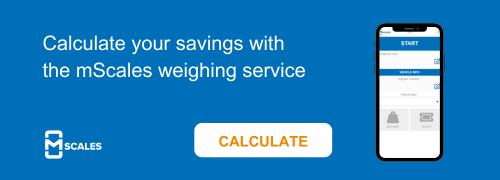A Wheel Loader Scale
The Wheel Loader Scale can weigh the material during the bucket lift, speeding up the weighing process during loading.
-
HERE you'll find general information about wheel loader scales and their use in various operations.
- HERE you'll find more information about the use of wheel loader scales for commercial weighing purposes.
- HERE some useful information about how simple it is to integrate a wheel loader scale with a cloud service.
- HERE we will explain how the wheel loader scale can be easily integrated into the weighing service.
- HERE you can delve deeper into what to consider when choosing a wheel loader scale.
- HERE are some helpful tips to ensure smooth wheel loader scale weighing.
A Wheel loader scale can be attached to the bucket of a wheel loader and it is used when loading a vehicle, sorting warehouse events, or transferring goods from one internal or external warehouse location to another. In other words, it performs loading or internal transfer of loads.
The wheel loader scale weighs the material during the bucket lift, thereby speeding up the weighing process during loading. With the wheel loader scale, the user has a real-time view of the inventory status because when using multiple storage locations, it is important to know how much material has been transferred and how much material is in the storage locations at any given time.
The wheel loader scale can also be referred to by various names such as a loader scale, loader scale, grapple scale, crane scale, and bucket scale.
In production, there are typically multiple storage locations, so it is important to know how much material is in the warehouses. The wheel loader scale provides up-to-date information on the inventory situation.
Connecting the wheel loader scale to a cloud service is modern. The weighing data can be directed directly to the correct projects, events, and construction sites via the cloud service, which improves weighing efficiency and reduces errors.
To operate, the wheel loader scale requires weighing electronics, a display terminal, hydraulic pressure sensors, boom and bucket position sensors, and a data transmission unit (gateway) to the data management system. Data management is nowadays almost always implemented in the cloud instead of in the loader. Printers were also previously widely used in loaders.
Below are the most common wheel loader scale accessories connected to the cloud service:
- Display terminal and weighing unit/counter
- mScales vehicle Gateway (including 4G SIM/Wifi)
- Boom and bucket limit switches
- Loader pressure sensor kit
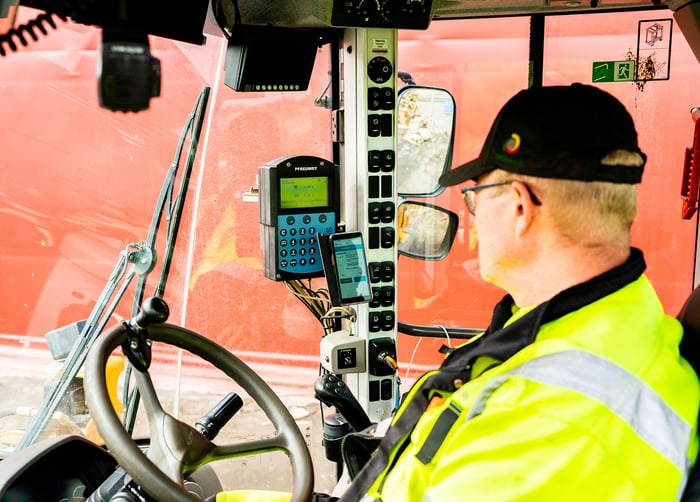
Read customer case: Metsäsairila's material flows are made more efficient by using mScales
The weighing process of wheel loader scales is typically based on measuring the change in pressure difference of the lifting device cylinders of the wheel loader over a certain stroke. However, there are mechanical frictions and internal hydraulic system leaks in the lifting device and loader, which naturally introduce inaccuracies into the weighing. These effects need to be minimized as much as possible to obtain accuracy from the scale. Wheel loader scales are aimed to be made as accurate as possible within the constraints of these factors. In real loading environments, experiments often achieve an accuracy of ±50-80kg with the actual load weight ranging from 3000-5000 kg.
Wheel loader scales are typically used for products with a not so high per kilo price, as it is not as precise a measuring instrument as, for example, a truck scale. However, since weighing occurs during bucket lifting, the process is quick. Therefore, the choice of measurement method determines how precise the measurement result is required and in what conditions the scale is used.
A wheel loader scale is typically equipped with two limit switches, where the weighing is started and stopped. During lifting, the actual weighing begins when the loader arm is at the lower limit switch and the weighing result is calculated when the arm is at the upper limit switch. Measurement takes place during dynamic movement, neutralizing the effect of frictions and ensuring that weighing is always done in a standardized manner.
The wheel loader scale is equipped with a sum counter, which calculates the total weights of lifts. This ensures that, for example, there are no overloads or underfills. Weighing data, position, and other events with additional information can be easily transmitted via the gateway to a cloud-based weighing service and further to the company's business systems.
Read more: How Do Wheel Loader Scales Work? Unlocking Efficiency in Material Handling
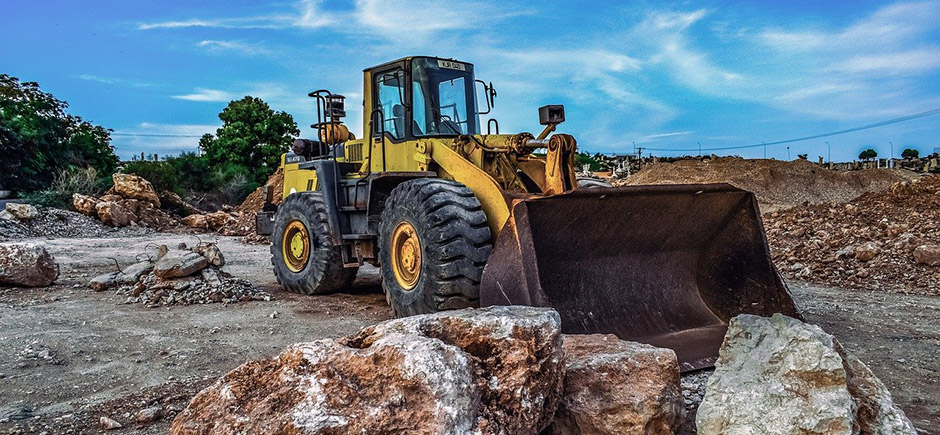
A wheel loader scale equipped with a totalizer calculates the sum weights of lifts, thus ensuring that there are no overloads or underfills.
For the consumer, a nearly everyday example of this is weighing fruits on the scale at the grocery store. The same applies to industry: if you are selling, for example, crushed rock at a price per ton, the scale used must be certified for commercial use. The scale intended for commercial use must be approved for the specific purpose. In addition, it must undergo initial verification before being put into use.
Usually, wheel loader scales are used for commercial weighing if a truck scale or a summing tank scale is not available or if a fixed scale for temporary use has not been acquired for the area. In this case, the loader scale must be separately certified for commercial weighing, which is referred to as a stability-approved scale. In Finland, the stability or verification of the scale is supervised by the inspection authority Kiwa Inspecta Oy.
The statutory verification interval for loader scales is three years. The dates of the last stability check and the next verification must be clearly marked on the loader scale and in a separate document. When working with a certified scale, you can be sure that it has been tested by the authorities to be sufficiently accurate, everything functions reliably, and the weighing data can be used for billing purposes.
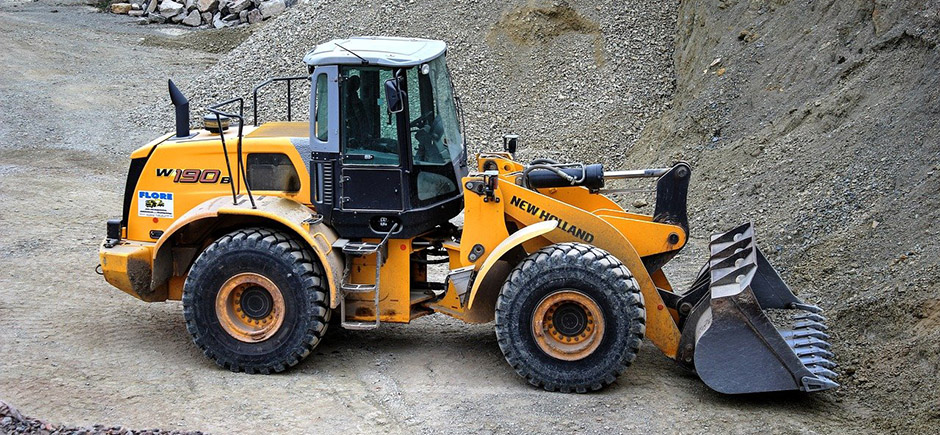
When weighing events are conducted repeatedly and stability is an essential part of the business, it's advisable to ensure that the wheel loader scale can be integrated into the company's business and logistics processes.
When seeking a functional and reliable wheel loader scale, it is important to consider the mass or specific gravity of the product being weighed, its physical state, the desired weighing accuracy, and the estimated usage volume per year. The desired operational process also imposes its own requirements on the loader scale, such as the frequency of loading, internal transfers, and sorting, as well as the conditions of the weighing location, including dust, temperature, vibration, and whether it is for indoor or outdoor use. The safety classification of the operating site may require special features or so-called minimum requirements from the loader scale.
Other factors to consider include the price and warranty terms of the weighing equipment, as well as whether spare parts and equipment support are readily available. Also, do you want to buy the loader scale outright or acquire it through leasing financing?
When weighing events are performed repeatedly and stability is an essential part of the business, it is advisable to ensure that the wheel loader scale can be integrated into the company's business and logistics processes. It is also worth considering what basic functions will be performed by the loader scale and what will be handled by the digital weighing service. It is not advisable to invest in an expensive weighing device that handles product, customer, and other business data. This can be managed by a cloud-based weighing service, which offers significantly broader usage, management, and reporting capabilities.
If commercial weighings are conducted with the loader scale, integration with a cloud service is easily accomplished if it has a free serial communication port (Modbus/Tcp), for example, for a printer device, and if it can generate standardized weighing messages and event data.
Digital weighing services can be easily integrated with loader scales in ports and logistics centres, where large quantities of bulk goods are handled, mixed, and packaged and where a truck scale is not available.
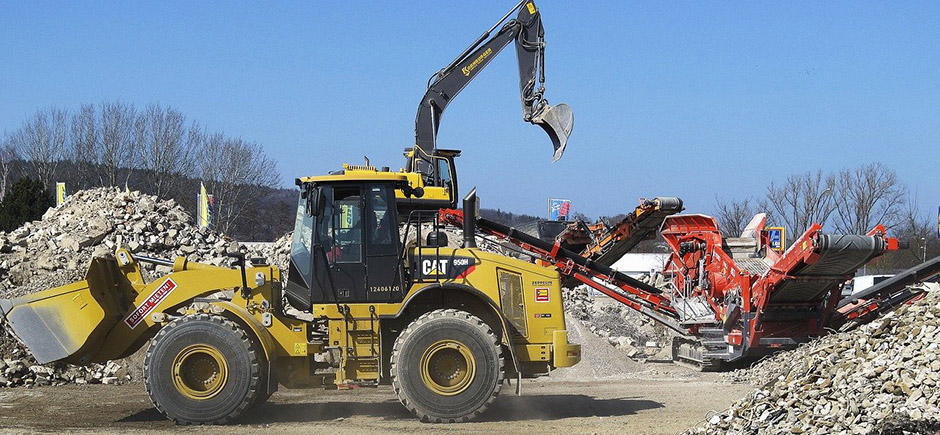
As a digital weighing service, mScales is utilized across all types and brands of scales in various industries, including infrastructure, mining, processing, energy, circular economy, and chemical industry.
With the advent of digitalization, the intelligence embedded in devices has migrated to cloud services, enabling continuous and rapid development of tools, as well as providing a better user experience and customization to user needs. Information can also be efficiently shared among all parties. A smartphone is a good example of this development. The same progress has now been realized in loader scale applications.
Weighing traditionally is complex, laborious, error-prone, and slow as a whole. The strengths of digital weighing services include minimizing errors, ensuring the timeliness of inventory information, and simplifying billing, as it can be done easily immediately after weighing. Advanced digital services enable efficient and up-to-date management of all material flows.
Through cloud services, billing for different gravel types leaving gravel pits can be easily managed. Weighing data is always targeted to the correct projects, events, and construction sites. The wheel loader driver can independently manage the flow of information in real-time via a mobile device, ensuring smooth data transfer.
Functional additional modules can be used to attach documents and photos to weighing events, electronic transport documents, and sample analysis data such as moisture percentage or calorific value, as well as provide additional information related to the construction site or project for billing purposes. This frees up resources for productive work, as time is not wasted on separate clarifications and manual paperwork.
Post-weighing documentation, such as electronic transport documents and transfer documents, is automatically obtained from the electronic weighing service. Signatures can be managed electronically, and all weighing data is available to various stakeholders in real-time through the service. This ensures fast and error-free billing.
Real-time information allows production and construction sites to be optimized for efficiency, and all reporting, real-time inventory management, and data transfer work seamlessly with the company's ERP or other business systems. The overall time savings throughout the entire order, delivery, and billing chain is significant - the more material transactions go through the loader scale, the more time is saved.
Remote access to loader scale access control can be managed remotely when integrated with a digital weighing service, and in such cases, remote support and remote maintenance services are also available based on customer requirements. For example, an additional module service offers gate control module, which enables 24/7 operation.
Digital services enable remote access control, monitoring of device operation status, remote support, and remote maintenance to be implemented remotely. Cloud services can easily be expanded to meet future needs. A modern digital solution enables adaptability to various changes in the operating environment, such as legislation, multi-company environments, subcontracting, and equipment rental models.
.png?width=602&height=467&name=MicrosoftTeams-image%20(139).png)
- mScales weighing service can be customized to meet the needs of customers and users.
- Fast and easy weighing with a mobile application.
- Each weighing event has its own weighing code. Electronic weighing documents.
- Easy and secure integration with business systems.
Connecting the wheel loader scale to a digital weighing service is easy and cost-effective. All scales can be integrated into the service regardless of the supplier. The mScales Vehicle Scale gateway is designed for mobile weighing equipment specifically for the demanding conditions in the Nordics, so it can withstand temperature variations and heavy vibrations. All weighing data is always available and reportable in real-time from anywhere. Data transmission and integration with the cloud typically occur via a 4G connection. The gateway must be connected to the actual scale terminal via a serial communication cable (Modbus/TCP).
Benefits of the digital weighing service:
- Provides certainty and traceability.
- Reduces overlapping functions.
- The service is safe to use.
- Billing can be initiated more quickly.
- Additional services can be added to the service as needed, such as electronic transport documents.
- No need for Excel entries and reporting.
- Basic scale is sufficient: no need for expensive equipment that handles business data.
- No need to print weighing receipts.
- No management of separate USB sticks.
Smooth weighing processes are achieved when the weighing is directly linked to either a customer order, transport agreement, internal warehouse order, or any purchase or sales transaction that requires invoicing. With the digital weighing service, one or multiple weighing codes can be created for events, with validity periods assigned, and sent to one or multiple wheel loader drivers.
If the scale is integrated into the cloud via the gateway:
- The driver uses the mobile weighing interface (code weighing).
- The driver prints the net weight of the loaded vehicle from the weighing terminal.
- The mScales Gateway reads the loaded net weight and sends the information to the web service.
- The mobile weighing interface displays the net weight on the weighing screen and receipt.
Alternatively:
- The driver can record weighings or material movements manually.
- The driver can perform weighings as a logged-in user on the web service.
- Mobile weighing can be initiated from the web service's order queue.
Weighings are directed from the wheel loader scale to the weighing service using a weighing code, and automatically distributed to all stakeholders, such as invoicing. Electronic transport documents, such as the waybill, and if necessary, waste transfer documents, are also obtained simultaneously. With the digital weighing service, warehouse events can also be managed using the warehouse management module. The user, usually the wheel loader driver in this case, can manage all information in real-time on their mobile device.
/New_07_2023/New_ENG_mScales_recycling_terminal.png?width=700&height=486&name=New_ENG_mScales_recycling_terminal.png)
Would you like to hear more about integrating mScales into your wheel loader scale?
Please schedule a suitable time from the calendar.


